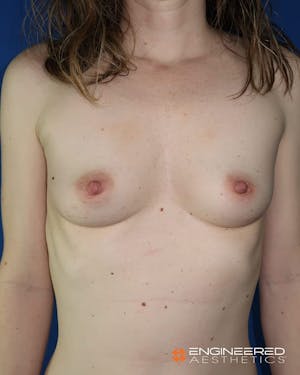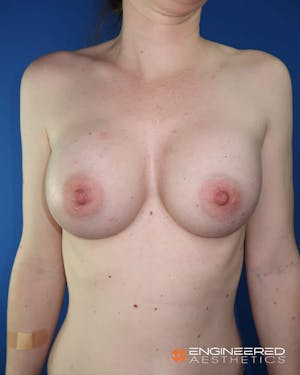Dissatisfaction with the size and shape of the breasts can cause many women to suffer from lowered self-esteem and negative self-image, but Dr. Engineer has the expertise and artistry to help you attain the natural-looking, larger breasts you desire with breast augmentation in Las Vegas.
What is the cost of a breast augmentation?
The cost of breast augmentation in Henderson varies depending on several factors, including the type of implants selected and the details of your surgical plan. Your final quote will reflect all associated fees, such as the surgeon’s fee, anesthesia, medical tests, medications, and post-surgical garments. A personalized estimate will be provided during your consultation.
What is breast augmentation?
Breast augmentation involves increasing the breast size through the use of implants, sometimes with the assistance of additional fat transfer to help ensure the most natural look. This procedure is often a major component of the mommy makeover, a series of treatments to help revitalize your figure after pregnancy.
While a breast augmentation in Henderson can help create a more ample bust, it cannot address breast ptosis, or sagging breasts, so often a breast lift procedure is performed in tandem with augmentation to create the most youthful contours in the chest area.

Who makes an ideal candidate for surgery?
Breast augmentation should be a well-considered decision that is based on a detailed consultation with your surgeon. Clients should be realistic in what they hope to achieve with surgery. Additionally, all patients undergoing a breast augmentation in Henderson should be of sound mind and body with no major medical concerns that might impede their surgery or recovery.
Patients should be non-smokers, or they must be willing to quit weeks prior to surgery, and stay quit for about a month afterwards as the body heals. Lastly, clients should be committed to following Dr. Engineer’s instructions at all phases of the treatment to ensure the best possible outcome.
What are the different types of implants available?
-
Saline Implants
Saline breast implants are surgically inserted and filled to the desired size the doctor and patient agreed upon, with a smaller incision than silicone implants, reducing postoperative scarring. In case of rupture, saline poses no health risks but requires replacement. These implants typically have a circular shape to enhance bust projection.
-
Silicone Implants
Silicone implants are pre-filled with silicone gel made to mimic the feel of natural breast tissue. The circular shape allows the breast augmentation to increase the size and protrusion of the breasts. Some patients feel that the look and feel of silicone implants create a more natural result.
-
Teardrop or anatomic implants
Anatomic implants are made of silicone, and are teardrop shaped instead of circular. Some women feel that this shape more naturally mimics their natural breast shape while providing the increase in size they desire.
What are the different types of incisions used during breast augmentation surgery?
Inframammary
An inframammary incision is placed where the lower breast creases meet the chest wall, affording the patient ample camouflaging for the resulting scars. This placement allows the surgeon the most freedom to reshape the breasts, and it is ideal for those who are seeking the largest cup sizes. An inframammary incision can be used for both saline and silicone breast implants.
Periareolar
Here, the incision is made as a semi circle around the nipple, with scarring well hidden by the darker colors of the areolar complex. This type of incision is appropriate for women seeking only a modest increase in cup size.
Transumbilical
During this approach, the incision is made through the belly button, creating a scar in a place where no one would ever see it. The implant is then tunneled up to the breast cavity and filled there. While scarring is minimized, the downside of this procedure is that the surgeon’s accuracy may suffer even when using an endoscope.
Transaxillary
The transaxillary incision is made within the armpit. The implants are then tunneled underneath the pec muscles to the breast pockets where they are filled to capacity. While scarring is minimized with this approach, the rates for complications such as infection and capsular contracture may be slightly higher.
What are the best placements for breast implants?
Each person will have a different amount of breast tissue to help cover the implants. For women with ample natural breast tissue, a subglandular implant placement may be ideal. Here the implant is placed behind the breast tissue and over the chest muscle. The benefits include an environment better suited to larger cup sizes; improved elevation of the breasts; reduced recovery time; and less discomfort.
During the submuscular placement, the implant is placed partially beneath the chest muscle. This may provide a more natural appearance and more coverage for those with a limited amount of breast tissue. Benefits include reduced risks of complications such as rippling or capsular contracture and less impediments during a mammogram.

What are the benefits of breast augmentation?
Benefits of a breast augmentation in Henderson include:
- Breasts more proportionate to the body
- Improved breast symmetry
- A more feminine, attractive figure
- A more youthful physique
- Increased wardrobe choices
- Improved self-confidence in one’s image
What can I expect from recovery?
Full recovery from breast augmentation may require 6 weeks, though most patients return to their work and social activities 7-10 days after the procedure. The first 3-5 days after the procedure tend to be the most uncomfortable.
While pain is easily managed with pain medication, a deep soreness is often felt. Bedrest, good nutrition, and very light daily exercise will help the recovery process go smoothly. You will be provided a detailed recovery plan and can contact us easily should anything unexpected occur or you simply have questions or concerns.

Nitin J. Engineer MD, FACS
Artistry, Focus, Experience.
Why choose Dr. Engineer for breast augmentation?
Dr. Engineer is committed to fully understanding your personal aesthetic goals and creating the safest, most appropriate surgical plan for you. He concerns himself not only with the success of each procedure but also with every patients' full experience from a breast augmentation in Las Vegas.
Personalized Breast Augmentation
At Engineered Aesthetics, you’ll experience personalized care from consultation to recovery. Dr. Engineer offers breast augmentation to women seeking enhanced proportions or post-mastectomy reconstruction, providing expert guidance for your procedure. Start your journey toward fuller, more youthful breasts by scheduling a consultation today.
Breast Augmentation FAQ
What’s the best age for breast augmentation?
Many patients in their 40 and 50s have successfully undergone breast augmentation. The average patient is in her mid 30s. If you are a mature adult of legal age, are in good overall health and would like to improve the appearance of your breasts, you’re likely at or near the right age for a breast augmentation.
Does breast augmentation affect nipple sensitivity?
Patients occasionally experience between about 6 and 12 months of reduced sensitivity in the breasts after a breast augmentation. For most patients who experience this, the breasts return to their previous levels of sensitivity, though up to 15% of patients can experience this longer.
How long after a breast augmentation can I start exercising?
You can and should start light exercise, like walking, right after surgery. More intense or strenuous exercises should be postponed for 6 to 8 weeks after surgery.
When can I start driving?
One week after surgery, provided you aren’t still taking pain medication that suggests otherwise.
Can I still breastfeed afterward?
Yes. There are certain incision types that provide a greater guarantee of this ability so be sure to tell your surgeon if this is important to you. (The periareolar incision is the least conducive to preserving the ability to breastfeed.)
Will breast implants affect my ability to detect breast cancer?
Breast implants do not prevent you from detecting breast cancer, but they can make mammograms more difficult to interpret. It’s important to let your radiologist know you have implants so they can take extra images to ensure accurate screening.
What’s the difference between saline and silicone implants?
Saline implants are filled with sterile salt water, while silicone implants are filled with a gel that feels more like natural breast tissue. Both have their pros and cons, so the choice depends on your aesthetic goals and personal preference.








